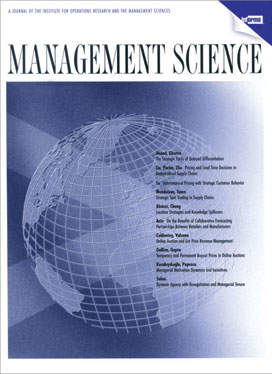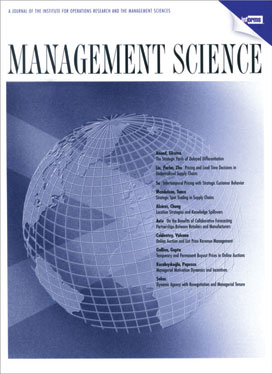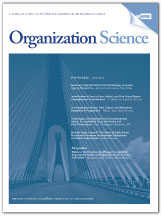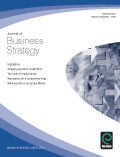Academic articles
Practitioner articles
Working papers
Books
Book chapters
Case studies
Other publications
Subject(s)
Strategy and general management
Keyword(s)
corporate social responsibility, competitive strategy, challenger brand, affective trust
This research builds on the complementary corporate social responsibility (CSR) literatures in strategy and marketing to provide insight into the efficacy of CSR as a challenger's competitive weapon against a market leader. Through an investigation of a real world CSR initiative, we show that the challenger can reap superior business returns among consumers who had participated in its CSR initiative, relative to those who were merely aware of the initiative. Specifically, participant consumers demonstrate the desired attitudinal and behavioral changes in favor of the challenger, regardless of their affective trust in the leader, whereas aware consumers' reactions become less favorable as their affective trust in the leader increases. Furthermore, participation, unlike mere awareness, transforms the nature of the consumer-challenger relationship from a transactional one to a communal, trust-based one.
© 2011 INFORMS
Volume
57
Journal Pages
1528–1545
ISSN (Online)
1526-5501
ISSN (Print)
0025–1909
Subject(s)
Technology, R&D management
Keyword(s)
innovation, commercialization, patents, multi-invention context
Volume
53
Journal Pages
47–79
Subject(s)
Economics, politics and business environment
Keyword(s)
competition policy, merger control, market definition, state aid, regulation
Volume
38
Journal Pages
287–314
Subject(s)
Marketing
Keyword(s)
CSR, marketing, corporate identity, consumer-company identification, identity alignment, marketing strategy
The paper integrates and builds on extant thinking in corporate marketing and CSR to provide an identity-based conceptualization of CSR. Based on this, it positions CSR as an optimal managerial tool for promoting alignment between multiple corporate identities (e.g., internal, external), which ultimately leads to key benefits for the company.
With permission of Emerald
Volume
45
Journal Pages
1353–1364
Subject(s)
Finance, accounting and corporate governance
Keyword(s)
default prediction, expected loss, recovery rate
In this paper we focus on modeling and predicting the loss distribution for credit risky assets such as bonds and loans. We model the probability of default and the recovery rate given default based on shared covariates. We develop a new class of default models that explicitly account for sector specific and regime dependent unobservable heterogeneity in firm characteristics. Based on the analysis of a large default and recovery data set over the horizon 1980-2008, we document that the specification of the default model has a major impact on the predicted loss distribution, while the specification of the recovery model is less important. In particular, we find evidence that industry factors and regime dynamics affect the performance of default models, implying that the appropriate choice of default models for loss prediction will depend on the credit cycle and on portfolio characteristics. Finally, we show that default probabilities and recovery rates predicted out-of-sample are negatively correlated, and that the magnitude of the correlation varies with seniority class, industry, and credit cycle.
© 2011 INFORMS
Volume
57
Journal Pages
1267–1287
ISSN (Online)
1526-5501
ISSN (Print)
0025–1909
Subject(s)
Strategy and general management
Keyword(s)
coordination, project work, knowledge work, technical work, open source software, lateral authority, communities of practice, community project, technical community, community forms
Project forms of organizing are theorized to rely upon horizontal as opposed to vertical lines of authority, but few have examined how this shift affects progression-how people advance in an organization. We argue that progression without hierarchy unfolds when people assume lateral authority over project tasks without managing people. With a longitudinal study of a mature, collectively managed open source software project, we predict the individual behaviors that enable progression to lateral authority roles at two different stages. Although technical contributions are initially important, coordination work is more critical at a subsequent stage. We then explore how lateral authority roles affect subsequent behavior-after gaining authority, individuals spend significantly more time coordinating project work. Our research shows how people progress to the center as opposed to up a hierarchy, and how progression differs by stage and specifies the theoretical relationship between lateral authority roles and the coordination of project work.
© 2011 INFORMS
Volume
22
Journal Pages
961–979
Subject(s)
Finance, accounting and corporate governance
Keyword(s)
banks, liquidity, money markets, repos, imbalance, short squeezing, financial health, liquidity networks, state guarantees
JEL Code(s)
G12, G21, E43, E58, D44
We study the prices individual banks pay for liquidity (captured by borrowing rates in repos with the central bank and benchmarked by the overnight index swap) as a function of market conditions and bank characteristics. These prices depend in particular on the distribution of liquidity across banks, which is calculated over time using individual bank level data on reserve requirements and actual holdings. Banks pay more for liquidity when positions are more imbalanced across banks, consistent with the existence of short squeezing. We also document that small banks pay more for liquidity and are more vulnerable to squeezes. Healthier banks pay less, but contrary to what one might expect, banks in formal liquidity networks do not. State guarantees reduce the price of liquidity, but do not protect against squeezes.
With permission of Elsevier
Volume
102
Journal Pages
344–362
Subject(s)
Strategy and general management
Keyword(s)
arts, leadership, leadership projection, story telling
Purpose - The paper "Made in heaven - produced on earth: creative leadership as art of projection" is about the concept of projection in the context of leadership.
Design/methodology/approach - This article takes a close look at Jeff Koons, a successful and highly controversial contemporary artist. The paper explores the way in which storytelling linked to his artwork has been the key element of the way he has projected himself as a credible leader in the world of contemporary art.
Findings - This article examines how the artist Koons is using the three universal story lines used by leaders to excite and gain buy-in from an audience as described by the sociologist Howard Gardner: (1) who am I - How life experience has shaped my individuality and character; (2) who are we - Demonstrate the values and behaviors of a group; and (3) where are we going - Explains what is new, and creates a sense of excitement about direction. The authors find that throughout his career and his various artistic production cycles like the inflatables, the New, Equilibrium, Luxury Degradation, Statuary, Kiepenkerl, Banality, Made in Heaven, Puppy, Celebration, Easyfun, Popeye, and Hulk Elvis, Jeff Koons is using key elements of the art of projection by linking his art work to the three universal story lines who am I, who are we, and where are we going. A closer analysis of Koons' work reveals how he has leveraged each of these dimensions of effective storytelling as a broad narrative to link his various series together as a consistent whole.
Practical implications - The authors suggest that Koons' use of storytelling, and the manner in which he has come to embody the themes and concepts that he seeks to communicate through his artworks, present powerful lessons for managers as to how they can manage their own leadership projection. By looking at Koons, managers can better understand not only how to establish credibility and drive buy-in, but also how to project themselves as leaders in their respective fields of business endeavor.
Originality/value - While there is literature on the art of storytelling there has been less focus on the sphere of art and how artists use storytelling and projection to take their audience with them. This new perspective not only creates new insights on the concept of storytelling and potential future research but has implications for managers and leaders and the way they want to drive change in organizations and take people on their managerial journey.
With permission of Emerald Insight
Volume
32
Journal Pages
12–24
Subject(s)
Finance, accounting and corporate governance
Keyword(s)
bank lending channel, loan supply, consumer lending, credit rationing, relationships
JEL Code(s)
G01, G21, F34
This paper examines the broader effects of the U.S. financial crisis on global lending to retail
customers. In particular we examine retail bank lending in Germany using a unique dataset of
German savings banks during the period 2006 through 2008 for which we have the universe of
loan applications and loans granted. Our experimental setting allows us to distinguish between
savings banks affected by the U.S. financial crisis through their holdings in Landesbanken with
substantial subprime exposure and unaffected savings banks. The data enable us to distinguish
between demand and supply side effects of bank lending and find that the U.S. financial crisis
induced a contraction in the supply of retail lending in Germany. While demand for loans goes
down, it is not substantially different for the affected and non-affected banks. More importantly,
we find evidence of a significant supply side effect in that the affected banks reject substantially
more loan applications than non-affected banks. This result is particularly strong for smaller and
more liquidity-constrained banks as well as for mortgage as compared to consumer loans. We
also find that bank-depositor relationships help mitigate these supply side effects.
With permission of Elsevier
Volume
100
Journal Pages
556–578
Subject(s)
Marketing
Keyword(s)
return on marketing
Volume
28
Journal Pages
8–12





